mail carrier
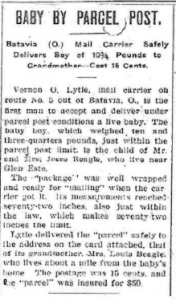
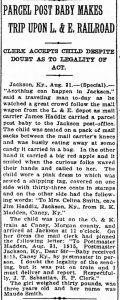 About 47 years ago, while on a family vacation to California, my brother-in-law, Ron Schulenberg decided that he wanted to stay in California, and when asked what they should do about his older brother, Bob, Ron said,”just send for him in the mail.” Unfortunately, Ron was a little late in history for his cool little idea. You see, while the mailing of children was a practice between 1913 and 1920, Ron was living in the year 1971. Nevertheless, while Ron’s idea was workable, he cannot be credited with the original idea.
About 47 years ago, while on a family vacation to California, my brother-in-law, Ron Schulenberg decided that he wanted to stay in California, and when asked what they should do about his older brother, Bob, Ron said,”just send for him in the mail.” Unfortunately, Ron was a little late in history for his cool little idea. You see, while the mailing of children was a practice between 1913 and 1920, Ron was living in the year 1971. Nevertheless, while Ron’s idea was workable, he cannot be credited with the original idea.
When the Post Office’s Parcel Post service officially began on January 1, 1913, the new service suddenly allowed millions of Americans access to all kinds of goods and services. That was a great thing, but as is often the case, it almost immediately had some unintended consequences. Believe it or not, some parents decided to send their children through the mail. Just a few weeks after Parcel Post began, an Ohio couple named Jesse and Mathilda Beagle “mailed” their 8-month-old son James to his grandmother, who lived just a few miles away in Batavia. It seems that Baby James was just under the 11-pound weight limit for packages sent via Parcel Post, and his “delivery” cost his parents only 15 cents in postage. Of course, being the “responsible parents” they were, they did insure him for $50. As you can imagine, this “delivery” made the newspapers very quickly. While you might have thought about the outrage that would have come from such an action these days, it did not. In fact, for the next several years, similar stories would occasionally surface as other parents followed suit. One famous case, on February 19, 1914, was that of a four year old girl named Charlotte May Pierstorff was “mailed” via train from her home in Grangeville, Idaho to her grandparents’ house about 73 miles away. Nancy Pope, who wrote for the National Postal Museum wrote the story, which became so legendary, that it was even made into a children’s book, Mailing May. Luckily, little May wasn’t unceremoniously shoved into a canvas sack along with the other packages. As it turns out, she was accompanied on her trip by her mother’s cousin, who worked as a clerk for the railway mail service, according to United States Postal Service historian Jenny Lynch. It’s likely that his influence (and his willingness to chaperone his young cousin) is what convinced local officials to send the little girl along with the mail.
In the next few years, stories about children being mailed through rural routes would crop up from time to time as people pushed the limits of what could be sent through Parcel Post. The reason being that postage was cheaper than a train ticket. One of the most overlooked, yet most significant innovations of the early 20th century might be the Post Office’s decision to start shipping large parcels and packages through the mail. While private delivery companies flourished during the 19th century, the Parcel Post dramatically expanded the reach of mail-order companies to America’s many rural communities, as well as the demand for their products. Over the years, these stories continued to surface from time to time as parents occasionally managed to slip their children through the mail thanks to rural workers willing to let it slide. Finally, on June 14, 1913, several newspapers including the Washington Post, the New York Times, and the Los Angeles Times all ran stories stating the the postmaster had officially decreed that children could no longer be sent through the mail. But while this announcement seems to have stemmed the trickle of tots traveling via post, Lynch says the story wasn’t entirely accurate. Soon, it became obvious that this bizarre practice had to be stopped, and on June 13, 1920, notice was given that the Post Office would no longer let children be sent through the mail. While child 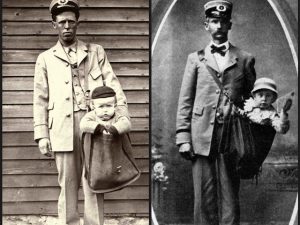
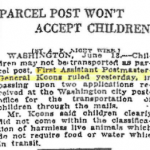 mailing stopped, there was a time when “Mail carriers were trusted servants, and that goes to prove it. There are stories of rural carriers delivering babies and taking care of the sick. Even now, they’ll save lives because they’re sometimes the only persons that visit a remote household every day.” Still, I don’t think I would mail my child somewhere. Thankfully, there are more travel options for children these days than pinning some postage to their shirts and sending them off with the mailman.
mailing stopped, there was a time when “Mail carriers were trusted servants, and that goes to prove it. There are stories of rural carriers delivering babies and taking care of the sick. Even now, they’ll save lives because they’re sometimes the only persons that visit a remote household every day.” Still, I don’t think I would mail my child somewhere. Thankfully, there are more travel options for children these days than pinning some postage to their shirts and sending them off with the mailman.
 Imagine being a mail carrier between 1863 and 1922. I’m sure that you are wondering why those dates would be so important. Well, they really are. In 1863, the United States Postal Service began what they called Free City Delivery. This service brought about the beginning of home delivery of the mail, at least in the cities. I suppose it also brought on the need for the mail carrier. What it didn’t bring with it was a large degree of efficiency. The mail carrier was required to go to the door of the patron receiving mail, and knock. Then they waited patiently for someone to answer the door to take the mail. That is about the strangest idea to me. The person would either need to be home every day at the time the mail carrier was supposed to be
Imagine being a mail carrier between 1863 and 1922. I’m sure that you are wondering why those dates would be so important. Well, they really are. In 1863, the United States Postal Service began what they called Free City Delivery. This service brought about the beginning of home delivery of the mail, at least in the cities. I suppose it also brought on the need for the mail carrier. What it didn’t bring with it was a large degree of efficiency. The mail carrier was required to go to the door of the patron receiving mail, and knock. Then they waited patiently for someone to answer the door to take the mail. That is about the strangest idea to me. The person would either need to be home every day at the time the mail carrier was supposed to be  there, or somehow know the date something was coming…an impossible task in those days, or have someone else there to watch for the carrier. It was estimated that the carriers lost over 1.5 hours a day, waiting on the patrons to come to the door.
there, or somehow know the date something was coming…an impossible task in those days, or have someone else there to watch for the carrier. It was estimated that the carriers lost over 1.5 hours a day, waiting on the patrons to come to the door.
As early as 1880, the post office began to suggest that people put a letter box on their door, so that the mail could be left at the house, even if no one was home. The Post Office wanted wall-mounted mailboxes to the outside of the houses instead of mail slots. They wanted them to be mounted at the height of a standing man. The plan was that the carrier would not have to bend over to deposit mail, and the outgoing mail would stay dry. People are notoriously slow to accept change, and I’m sure this situation was no different.
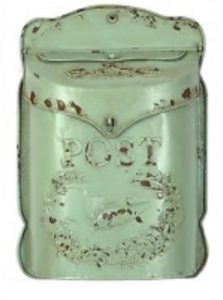
By 1916, with little change in the situation, the post office began working on a plan to achieve the compliance they needed. The deadline was set. The homes were to have a letter box by March 20, 1922. After that date, the mail would be held at the post office, if no letter box was in place. As we look back now, it seems strange to think that anyone would fight the letter box plan. It’s such a simple way to get your mail, and it does not involve a daily trip to the post office. I can’t imagine why anyone would want the hassle that not having a mail box at your home would bring. I think they probably felt same way after they had one for a while.

